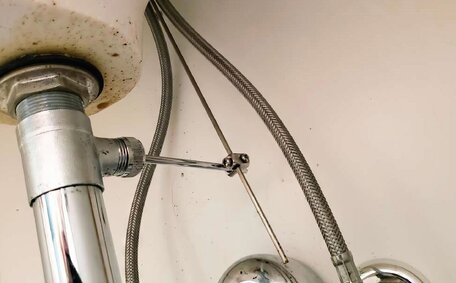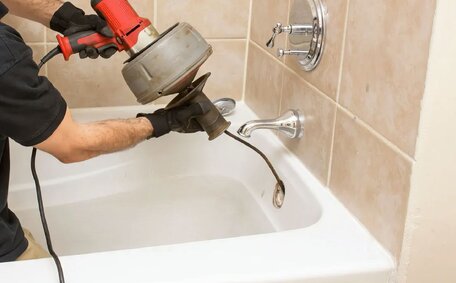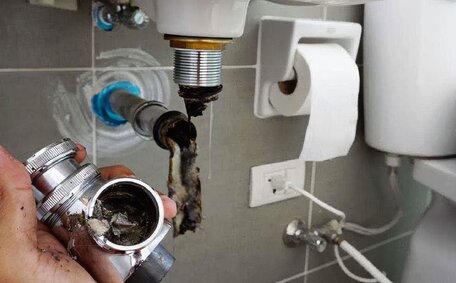Understanding Pipe Relining and Its Importance
Pipe rehabilitation through relining is a trenchless technique that repairs damaged pipes without excavation. This method inserts a resin-soaked liner into the pipe, curing it in place to create a smooth, new "pipe within a pipe" – a streamlined solution for blocked drains, eliminating the need to dig.
Weighing the pros and cons of pipe relining versus replacement reveals that relining is generally favoured for its less invasive, more cost-effective, and quicker resolution of plumbing system issues. The key benefits of pipe relining, applicable to a range of pipe materials, include:
- Significantly reduced disruption to your home or business, as it swiftly addresses cracks and leaks from within the pipe infrastructure
- Extends pipe lifespan for decades
- Ensures water flow moves efficiently
Whether you’re dealing with drain pipe relining, relining sewer pipe, or water pipes, our trenchless pipe lining method allows us to deliver an effective repair without the mess and headaches of a complete pipe replacement. The relining method is a compelling solution for your residential and commercial drain repair and sewer pipe maintenance.
Methods and Materials Used in Pipe Relining
Pipe relining professionals primarily utilise two methods to ensure efficient repair:
- Cured-In-Place Pipe Lining (CIPP): This involves inserting a resin-impregnated felt tube into your existing pipes and curing it in place using hot water or steam. As it cures, it hardens to form a smooth, jointless "pipe within a pipe", a robust addition to your property’s pipe lines that restores structural integrity and seals cracks and leaks.
- Spiral Winding: Spiral Winding employs a fibreglass cloth impregnated with a two-part epoxy resin, spirally wrapped to create a seamless liner inside existing pipes, often used for lateral pipes and fittings.
We use specialty resin systems formulated as epoxy polymers engineered to withstand pressure, temperature fluctuations, soil stresses, and effluent flow during the pipe relining process. These formulated epoxy polymers are designed to meet water authority standards for contact with drinking water.
Other auxiliary materials involved in pipe relining projects, especially for drains sewer pipes, include:
- CCTV drain cameras for pre- and post-relining pipe inspection, ensuring a quality finish
- High-pressure water jetters to clean and prepare pipes
- Calibration devices make sure liners are accurately sized for an exact fit
- Control units for steam/hot water curing
- Resin impregnation devices
- Inflatable bladders are vital for the inversion lining process, ensuring a snug fit within the host pipe
- Cutting devices to reopen service connections
Often, relined pipes from trenchless interventions become as robust, if not more than, the original pipes. They provide a long-lasting solution for sewer pipe relining, as well as restoring damaged sewer lines, water lines, and more in residential and commercial settings.
When to Choose Pipe Relining Over Replacement
Pipe relining, designed to avoid damaging surrounding areas, is often more cost-effective than traditional methods. Our experts are adept at identifying the best approach in various situations:
- When pipes have surface damage like cracks or leaks but are still structurally sound overall
- For pipe repairs above ground or under structures such as your garden or driveways where excavation would be highly disruptive
- To address root intrusion issues around your sewer lines without the disruptive digging
- In apartment buildings or densely built urban areas where pipe access is difficult
- For swift maintenance when old pipes can’t have their water supply shut off for long durations
- As preventative maintenance, it is an ideal remedy for a damaged drain, aimed to extend pipe lifespan and forestall future failures
Pipe relining can revitalise pipes made of diverse materials such as PVC, clay, concrete, galvanised steel, copper, and cast iron, all susceptible to damage, corrosion, scale buildup, or root incursions. It offers a faster, less invasive, and more affordable pipe repair method for old damaged infrastructure compared to replacing the entire piping system.
When pipes malfunction and replacement appears as a last resort, pipe relining emerges as the ideal solution without digging.
Step-by-Step Process of Pipe Relining
Conducting a pipe relining project involves several key stages:
- Initial CCTV Inspection: A drain camera is guided through an access point into your pipes to pinpoint damage, leaks, blockages etc., and assess the suitability for relining.
- Jet Washing and Cleaning: High-pressure water jets thoroughly cleanse the interior pipe walls before relining.
- Sizing and Calibration: Precise pipe dimensions are obtained using gauges to ensure accurate sizing of the custom-fitted epoxy resin liner.
- Resin Impregnation: The liner is infused with specialist epoxy resin suitable for both potable and non-potable water contact.
- Liner Insertion: The resin-soaked liner is inserted into the host pipe, broadening to seal any cracks, gaps, and leaks.
- Curing: Hot water or steam is circulated to cure the resin and harden the liner.
- Reopening Connections: Services connections to the main pipe are reopened using remote-controlled cutting devices.
- Final CCTV Inspection: Cameras check the pipe relining quality and that normal flow has been restored.
The entire procedure is a time-saver, completed in just a few hours with minimal disruption, showing efficiency much faster than traditional pipe repair methods. Relined pipes often emerge stronger than new ones.
Benefits of Pipe Relining
There are numerous advantages to pipe relining instead of full replacement:
- Pipe relining is markedly more cost-effective, reducing costs by 50-80% compared to traditional excavation and replacement.
- Minimal disturbance to your property, no need for your peace to be disrupted as we come out, your drains remain intact, and there’s no necessity to lay new pipes – say goodbye to jackhammers, teams trudging through, or hefty machinery.
- Speed – pipe relining takes just hours while replacement can take days/weeks.
- Longevity – relined pipes last 50+ years.
- Improved flow – smooth pipe interior stops buildup and blockages.
- No destruction to your yard or gardens.
- Eco-friendly – reduces landfill waste from old pipes.
Particular advantages of relining your drains and sewer pipes entail:
- Fixes root invasion problems in your drain without any need to dig up your property.
- Fixes the issue of broken pipes, restoring structural integrity of cracked drains and averting future tree roots intrusion.
- Resists corrosion, infiltration and future tree root damage.
- Prevents leaching of pipes into surrounding soil.
In summary, pipe relining enables fast, affordable, low-impact repairs that keep your plumbing drainage system flowing efficiently for decades. Our team, with extensive experience in pipe relining Brisbane homes and businesses, is prepared to determine if it’s optimal for your situation.
Considering the Costs of Pipe Relining
When considering the costs of pipe relining, there are several factors to take into account:
- Type of pipe – costs vary for sewer lines, water lines, lateral pipes etc.
- Pipe size and length – longer/wider pipes require more liner material and resin.
- Location and accessibility – ease of accessing the pipes influences labour costs.
- Extent of damage – minor cracks vs major corrosion and holes.
- Additional components – junctions, bends, connections add expenses.
Pipe relining typically costs between $80-250 per linear metre, with a standard 60m sewer line relining ranging from $5,000-$15,000+, varying with the aforementioned factors.
Although pipe relining requires an initial investment, its value over full replacement in the medium to long term is now well recognised. You save significantly on excavation, new pipe materials, garden/landscaping restoration and labour. In some scenarios, relining pays for itself in less than five years, ensuring many years of ongoing savings.
We highly recommend getting professional method pipe condition assessments and relining quotes to understand the solution your particular circumstances may require. Often pipe relining provides a very cost-effective trenchless repair method that saves thousands in the short and long run.
Ensuring Quality Work and Compliance
Ensuring quality workmanship and compliance with industry standards is crucial when conducting pipe relining projects. Does pipe relining meet your needs? There are a few key steps to follow:
- Verify technicians are certified and licenced to perform pipe relining per local regulations. Proper credentials indicate adequate training and expertise.
- Check for membership in industry bodies like NASSCO (National Association of Sewer Service Companies) which require adherence to strict codes of practise.
- Review company qualifications like years of experience, reputation, testimonials etc. An established local plumbing service provider understands state regulations.
- Confirm the use of quality materials that meet the relevant product standards. The epoxy resins used should be specially formulated for your water pipes, ensuring potable and non-potable safety.
- Ensure proper protocols are followed for pipe preparation, calibration, liner insertion, curing and reopening of connections.
- Verify adequate project warranties. Many companies offer guarantees up to 10 years when relining is done properly.
For homeowners in Sans Souci, Sydney, your plumber of choice for comprehensive pipe relining services in Brisbane is Sans Souci Plumbing, with its expertise in trenchless techniques. Our team of pipe relining experts, providing relining Brisbane services, are trained in the latest trenchless repair methods. We can provide long-term warranties and always conform to NSW plumbing codes for guaranteed safe, quality outcomes.
Innovations in Pipe Relining
Our team keeps abreast of the latest pipe relining techniques, including advanced materials and application methods. Some recent advancements include:
- Enhanced resin systems with greater heat and chemical resistance for longer liner lifespan.
- Nanotechnology coatings that create an ultra-smooth surface to further resist buildup and corrosion.
- Robotic devices for more precision in liner insertion and calibration.
- High-density polyethylene (HDPE) liners, which can be used as a strong option apt for potable water pipes.
- Steam-accelerated resin curing can also expedite installation and facilitate the relining of longer pipe sections.
- This innovative technique enables us to perform trenchless pipelining for lateral connections and hard-to-access service lines.
These innovations allow for more durable, extensive and cost-effective relining projects with less disruption. They enable pipe repairs that can add 50-100 years of lifespan in just days without excavation. With ongoing improvements, relining technology offers an ever-evolving pipeline renewal approach for homes and businesses.
Choosing the Right Pipe Relining Professionals
When selecting a contractor for pipe relining, it is important to verify their expertise, reputation and credentials. Look for companies who:
- Employ fully licenced, certified plumbers with specialised training in pipe relining best practises to get job done efficiently and your pipes functioning optimally
- Have an established history and proven track record relining residential and commercial pipes, with many positive customer reviews
- Are members of industry bodies like NASSCO, indicating strict adherence to codes of practise
- Use high quality resin systems and liners compliant with water contact standards
- Follow rigorous protocols for pipe inspection, cleaning, measurement, liner insertion and resin curing
- Provide long-term warranties on completed pipe relining projects
Sans Souci residents in need of professional pipe relining solutions can contact our office at Sans Souci Plumbing, ensuring they receive all the assurances required for drain relining and sewer repair needs. Our team have completed numerous successful drain and sewer relining projects across Sydney. You can get your pipes expertly mended by contacting our team today, discovering how swiftly we can rectify the issue without the disarray of excavation.
Maintaining Your Relined Pipes
Proper maintenance is pivotal for guaranteeing that any plumbing repairs, especially relined pipes, continue operating optimally for the foreseeable future. We recommend following these care tips:
- Conduct annual CCTV inspections to check your pipes’ liner condition and catch any new issues early.
- Avoid pouring fats, oils, and harsh chemicals down drains that could degrade liner material over time.
- Use enzyme cleaners or degreasers monthly to break down buildup and keep relined drain pipes flowing freely.
- Install basket strainers in sinks to catch food scraps and debris before entering pipes.
- Consider professional hydrojetting every 2-3 years to wash away any sediment accumulation.
- Watch for leaks, cracks or odd gurgling sounds that may indicate problems requiring attention.
By regularly inspecting and maintaining your relined plumbing system, you can extend its lifespan for decades while avoiding expensive failures or backups. Should you notice any issues, promptly contacting our dedicated team simplifies repairs through early problem identification.
With proper care, quality pipe relining results can serve you reliably for 50-100 years. But neglecting maintenance may allow buildup, roots or corrosion to eventually compromise the integrity of liners. Protect your investment and residential plumbing health with proactive maintenance.
For assistance creating a maintenance plan tailored to your home or business, Sans Souci Plumbing offers custom pipe upkeep solutions. Contact us today.






